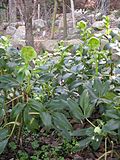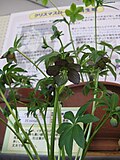Hellebore
Hellebore is a type of flowering plant that belongs to the family Ranunculaceae. The term "hellebore" is derived from the Greek words "elein" meaning to injure, and "bora" meaning food, referring to the plant's toxic properties. Hellebores are native to Europe and Asia, and are commonly known for their early blooming period, often in late winter or early spring.
Description
Hellebores are perennial plants with leathery leaves and large, bowl-shaped flowers. The flowers come in a variety of colors, including white, green, pink, and purple. The plants typically grow to a height of 12 to 15 inches, and are often used in gardening for their ornamental value.
Toxicity
All parts of the hellebore plant are toxic if ingested. The plant contains several types of toxic compounds, including glycosides and alkaloids. Symptoms of hellebore poisoning can include nausea, vomiting, diarrhea, and abdominal pain. In severe cases, ingestion can lead to cardiac arrest and death.
Medical Uses
Despite its toxicity, hellebore has been used in traditional medicine for centuries. It was used by the ancient Greeks to treat mental disorders, and has also been used as a purgative. However, due to its toxic properties, hellebore is not commonly used in modern medicine.
Cultivation
Hellebores are hardy plants that can tolerate a range of conditions. They prefer shady locations and well-drained soil. Hellebores are often propagated by division in the spring or fall.
See Also
References
Transform your life with W8MD's budget GLP-1 injections from $125.
W8MD offers a medical weight loss program to lose weight in Philadelphia. Our physician-supervised medical weight loss provides:
- Most insurances accepted or discounted self-pay rates. We will obtain insurance prior authorizations if needed.
- Generic GLP1 weight loss injections from $125 for the starting dose.
- Also offer prescription weight loss medications including Phentermine, Qsymia, Diethylpropion, Contrave etc.
NYC weight loss doctor appointments
Start your NYC weight loss journey today at our NYC medical weight loss and Philadelphia medical weight loss clinics.
- Call 718-946-5500 to lose weight in NYC or for medical weight loss in Philadelphia 215-676-2334.
- Tags:NYC medical weight loss, Philadelphia lose weight Zepbound NYC, Budget GLP1 weight loss injections, Wegovy Philadelphia, Wegovy NYC, Philadelphia medical weight loss, Brookly weight loss and Wegovy NYC
|
WikiMD's Wellness Encyclopedia |
| Let Food Be Thy Medicine Medicine Thy Food - Hippocrates |
Medical Disclaimer: WikiMD is not a substitute for professional medical advice. The information on WikiMD is provided as an information resource only, may be incorrect, outdated or misleading, and is not to be used or relied on for any diagnostic or treatment purposes. Please consult your health care provider before making any healthcare decisions or for guidance about a specific medical condition. WikiMD expressly disclaims responsibility, and shall have no liability, for any damages, loss, injury, or liability whatsoever suffered as a result of your reliance on the information contained in this site. By visiting this site you agree to the foregoing terms and conditions, which may from time to time be changed or supplemented by WikiMD. If you do not agree to the foregoing terms and conditions, you should not enter or use this site. See full disclaimer.
Credits:Most images are courtesy of Wikimedia commons, and templates, categories Wikipedia, licensed under CC BY SA or similar.
Contributors: Prab R. Tumpati, MD












